 Mysteries
Mysteries  Mysteries
Mysteries  History
History 10 Surprising Stories About the Texas Rangers
 Humans
Humans 10 Philosophers Who Were Driven Mad by Their Own Theories
 Miscellaneous
Miscellaneous 10 Video-Game-Worthy Weapons and Armors from History
 Weird Stuff
Weird Stuff 10 Psychics Who Accurately Predicted Wartime Events
 The Arts
The Arts 10 Pieces of Art Inspired by a Broken Heart
 Health
Health 10 Science Fiction-Sounding New Medical Treatments
 History
History 10 Surprising Facts About the Father of Submarine Warfare
 Space
Space Ten Astonishing New Insights into Alien Worlds
 Weird Stuff
Weird Stuff 10 Bizarre Summer Solstice Rituals Still Practiced Today
 Mysteries
Mysteries Top 10 Haunting Facts About the Ghost Ship MV Alta
 History
History 10 Surprising Stories About the Texas Rangers
 Humans
Humans 10 Philosophers Who Were Driven Mad by Their Own Theories
Who's Behind Listverse?

Jamie Frater
Head Editor
Jamie founded Listverse due to an insatiable desire to share fascinating, obscure, and bizarre facts. He has been a guest speaker on numerous national radio and television stations and is a five time published author.
More About Us Miscellaneous
Miscellaneous 10 Video-Game-Worthy Weapons and Armors from History
 Weird Stuff
Weird Stuff 10 Psychics Who Accurately Predicted Wartime Events
 The Arts
The Arts 10 Pieces of Art Inspired by a Broken Heart
 Health
Health 10 Science Fiction-Sounding New Medical Treatments
 History
History 10 Surprising Facts About the Father of Submarine Warfare
 Space
Space Ten Astonishing New Insights into Alien Worlds
 Weird Stuff
Weird Stuff 10 Bizarre Summer Solstice Rituals Still Practiced Today
10 Foods That Have Been Genetically Modified Beyond Recognition
Would you eat or even recognize these foods in their original forms? Chances are that you wouldn’t.
Genetically modified foods are a big source of debate these days. Some don’t want anything to do with modern GMOs, while others are all for them. However, a lot of people don’t realize that many of today’s fruits and vegetables wouldn’t exist without careful selective breeding. In fact, the original versions of these popular plants might be downright unrecognizable to the modern public.
10 Carrots
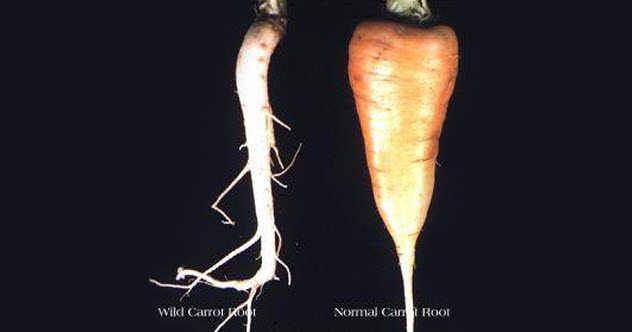
The earliest known cultivated carrots were first grown in the 10th century in Asia Minor and Persia. Before it was domesticated, the wild carrot was spread all over the world. Seeds up to 5,000 years old have been discovered in Europe.
The carrot’s original appearance was small and white. It also had more of a forked appearance like a plant root. Most likely, ancient cultures used it as a medicinal plant.[1]
It’s thought that the carrot’s transformation into the orange, sweet, less bitter descendant so popular today took many centuries to breed. Today’s orange carrots are known as Carotene or Western carrots, while their cousins are known as Asiatic or Eastern carrots, which have purple and sometimes yellow roots.
9 Eggplants

No one can mistake a big, purple, shiny eggplant for anything other than what it is. However, eggplants actually have many varieties. The eggplant was first domesticated in what is modern-day India and Burma. Today, it’s widely cultivated in the land that stretches from northeast India and Burma to Northern Thailand, Laos, Vietnam, and southwest China.
The word “eggplant” is said to come from the British occupation of India, where the plants were white and egg-shaped. Writings from as early as 300 BC describe the plant in a variety of ways—as the “blue” fruit, as the royal melon, and as having spines.[2]
Over the centuries, the plant migrated across Asia, the Middle East, Europe, and North America. The plant in its various forms was often included in early art and literature from these regions.
8 Bananas
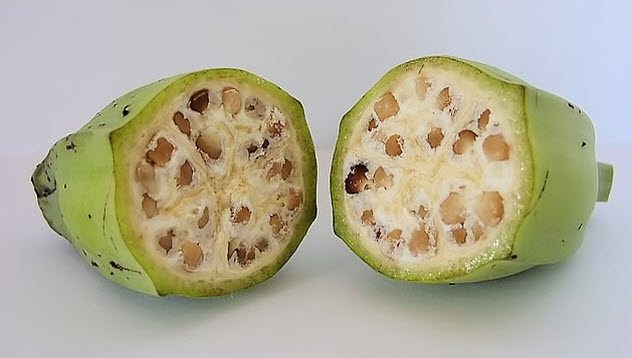
The fleshy yellow fruit found in so many kids’ lunchboxes was first cultivated in Papua New Guinea between 7,000 and 10,000 years ago. The banana is yet another edible plant with several varieties, most of which are found today in Asia.
The long, yellow variety, known as the Cavendish, is the result of centuries of careful breeding by diligent agriculturalists. It descends from two wild banana species: Musa acuminata and Musa balbisiana. The former has flesh that isn’t very tasty when eaten raw, and the latter is a short, stubby little thing with lots of hard, pea-sized seeds in the middle.[3]
Thousands of years ago, banana cultivators discovered that cross-pollinating these two plants sometimes produced a sweet, yellow, seedless fruit that was also rich in nutrients. As this variety is seedless, these bananas must be produced by human-assisted asexual propagation (otherwise known as cloning).
This form of reproduction makes the Cavendish much more susceptible to disease than its hardy ancestor. Since the plants are genetically uniform, a banana-killing pestilence could quickly and easily wipe out whole crops. For this reason, cultivators are careful with their output lest the world experience a banana apocalypse.
7 Tomatoes
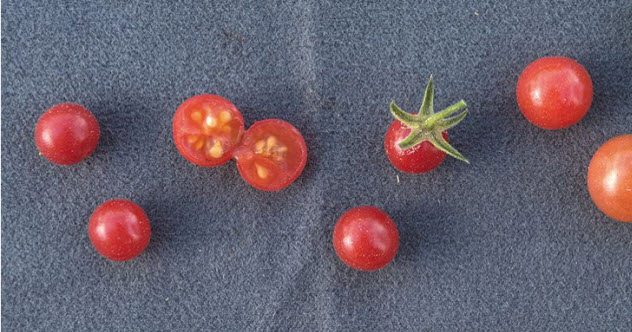
Wild Tiny Pimp might sound like an unfortunate street name, but it’s actually the name of a tomato species. In fact, it’s the tomato species from which all other tomatoes descend. Plant scientists call it Solanum pimpinellifolium, or just “pimp.”
Today, these pea-sized tomatoes grow on scraggly vines found in northern Peru and southern Ecuador. South Americans first domesticated them during the pre-Columbian era.[4] Then these tomatoes spread to Europe and eventually back to North America.
Today’s wide assortment of domesticated tomatoes all come from the tiny pimp and, interestingly enough, only have five percent genetic variation between them. Crossbreeding modern types with the earlier wild ones, including the pimp, produces a plant that’s hardier and less susceptible to disease.
6 Watermelons
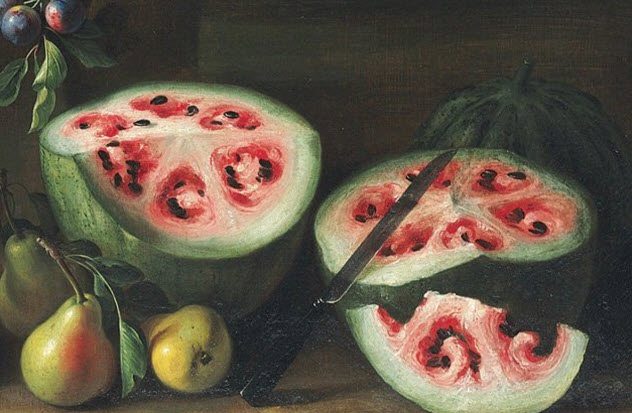
Theories abound concerning where exactly the watermelon originated. Historians only agree that it first grew somewhere in Africa, spread to the Mediterranean, and later popped up in Europe.
Harry Paris, a horticulturalist at the Agricultural Research Organization in Israel, has concluded that the watermelon’s earliest ancestor was first cultivated in Egypt some 4,000 years ago. This ancient fruit was hard, bitter, and pale green in color—a far cry from today’s sweet, fleshy variety.
So why would the ancient Egyptians want to spend time and energy growing something like that?
Paris believes that they were cultivated simply for their water. During the dry season, watermelons stored well and the Egyptians could pound them to a pulp and extract their water content. He also believes that the Egyptians were the ones who began the selective breeding process that ultimately led to watermelon as we know it.[5]
5 Corn
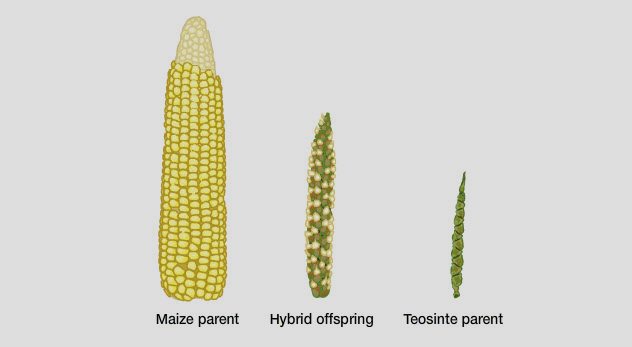
It’s hard to imagine a world without this most essential staple crop. Corn was one of the first food plants cultivated at the start of human agriculture some 10,000 years ago in the area that is modern-day Mexico. At one time, ears of corn were very small and gradually became bigger over time thanks to artificial selection.
If we go back even further, we find that corn’s ancient ancestor is a wild grass plant called teosinte. It looks very little like corn, though they both produce kernels. On a genetic level, though, the two plants are quite similar.[6]
Geneticist George Beadle found in his experiments that there were only five chromosomes responsible for the most noticeable differences between the two plants. Teosinte underwent small genetic changes over time that eventually resulted in the appearance of maize.
4 Peaches
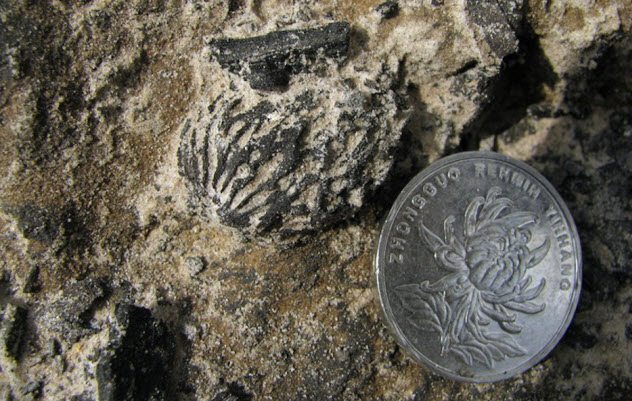
The peach has quite a long history. In fact, peach pit fossils have been discovered in China that are 2.5 million years old. These peaches were smaller than today’s variety. They more closely resembled small cherries and had very little flesh.[7]
It took about 3,000 years for the peach to reach its modern appearance. Unsurprisingly, peaches have an important part in Chinese culture. They symbolize long life and are commonly found in markets throughout the country.
3 Avocados
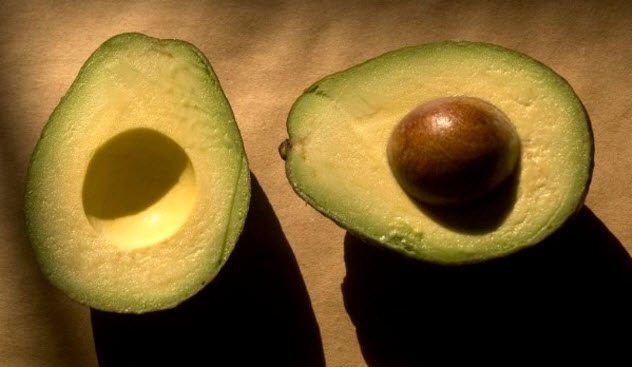
The fleshy fruit responsible for the tastiness of guacamole was originally a snack for prehistoric giant mammals 65.5 million years ago. In fact, these animals were the avocados’ sole mode of transportation since they would eat the fruit whole and then poop out the seed later in another location.[8]
The original avocado had a bigger pit (if you can imagine that) and much less flesh than today’s Hass avocados. Sometime after the large mammals died out, humans took to cultivating the fruit so that it became fleshier and more appealing over time.
2 Papayas
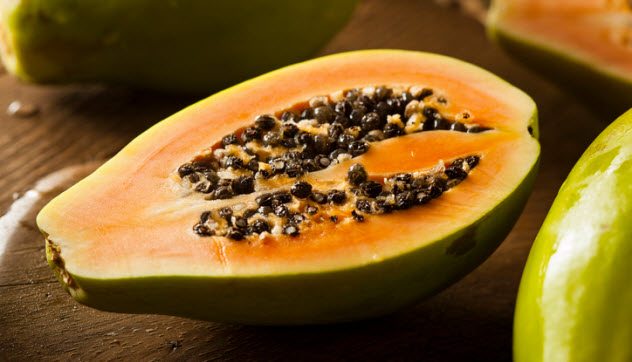
Though papaya is eaten around the world today, it originated in the tropical climate of Latin America. The modern commercial papaya descends from the wild papaya, and they both have very different appearances.
The wild papaya is round and about the size of a plum.[9] Some species even closely resemble a cacao pod. The ancient Maya were the first to cultivate papaya about 4,000 years ago. Growing the fruit is a complicated process because the grower doesn’t know which seeds will produce fruit-bearing plants until after they’ve begun to grow.
1 Pumpkins

The original word for “pumpkin” came from the Greek word pepon, which means “large melon.” Over time, the word was morphed into what we now know it as. Pumpkins and squash are believed to have originated in the early Americas. The earliest pumpkins were the size of a softball, tasted bitter, and were toxic when raw.
Only large prehistoric mammals could eat them, so these creatures alone were responsible for spreading the seeds around. When these mammals died out, the pumpkin could have gone with them if it weren’t for human cultivation.[10]
Humans would go on to find various uses for hollowed-out pumpkins and gourds, such as containers for water. Eventually, they began eating pumpkins and saving the seeds of the tastier types for replanting. It kind of makes you appreciate pumpkin spice lattes a bit more.
Tiffany is a freelance writer hailing from Southern California. She’s a fan of pop science and considers herself a human repository of random facts.
Read more disturbing facts about the foods you eat on 10 Disturbing Facts About Popular Snack Foods and 10 Foods Made From Poop, Vomit, Or Spit. Would You Eat Them?.








